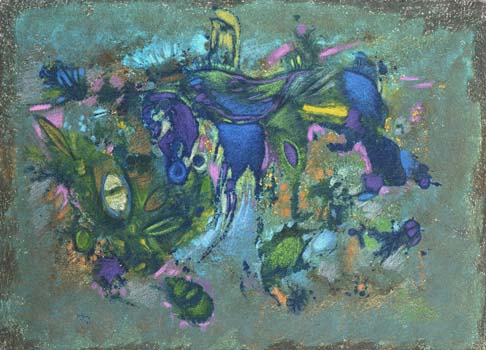Charles Seliger / The Art of Organic Forms
dal 13/3/2003 al 3/5/2003
Segnalato da
13/3/2003
Charles Seliger / The Art of Organic Forms
Michael Rosenfeld Gallery, New York
Two exhibitions. The Art of Organic Forms: our contemporary exhibition concentrates on artwork from the 1940s by sixteen American artists, six of whom were included in the original exhibition. By appropriating the Surrealist technique of automatism, artists such as Peter Busa, Arthur Dove, Gerome Kamrowski, and Boris Margo found their voices in what Theodoros Stamos called, 'abstract surrealism', now known as organic abstraction. Like many artists of his generation, Seliger was deeply influenced by the Surrealists' use of automatism, and throughout his career he has cultivated a deeply poetic style of abstraction that explores the relationship of order and chaos found in nature.

The Art of Organic Forms
In 1968, Philip C. Ritterbush curated the provocative exhibition The Art of Organic Forms for the Smithsonian’s Museum of Natural History in Washington, DC. This historic exhibition, one of the first to examine the character of science by demonstrating its affinities with the arts, explored "the notion that organized beings display principles of emergent order of greater complexity than nonliving entities, whereby organic form is seen to be a property of the whole organism, in distinction to the forms of its parts or subordinate elements." The exhibition posed the question: What do organic motifs in abstract art have to tell us about science and imagination? By including seventy-one abstract works from 1905 to 1968, by fifty American and European artists, the exhibition attempted to give aesthetic content to the science of biology, specifically to the study of organisms which lie beyond the range of unaided vision.
The exhibition venue - a museum dedicated to the understanding of the natural world and man’s place in it (made it possible for viewers to enjoy works by Arthur Dove, Max Ernst, Arshile Gorky, Paul Klee and numerous others before investigating the permanent displays of fossils, animals, minerals, rocks, plants and human artifacts. Discovering beauty in unexpected forms and unexpected places prompted the acceptance of an abstract visual language rooted in the natural world. When interviewed in 1968 by critic Joy Billington for The Evening Star, artist Charles Seliger - whose work was included in the exhibition) stated, "many painters who are concerned with form for its own inherent beauty have waited a long time to see a show like this. The Smithsonian has jumped into a void in a way that art museums have missed."
Thirty-five years later, Michael Rosenfeld Gallery presents a rendition of The Art of Organic Forms that is faithful to the original concept but more narrowly focused. Our contemporary exhibition concentrates on artwork from the 1940s by sixteen American artists, six of whom were included in the original exhibition.
The 1940s was a decade of artistic transition; narrative surrealism as exemplified by Salvador Dalà and Renè Magritte was no longer relavent, and a younger generation of American artists searched for a new visual language. By appropriating the Surrealist technique of automatism, artists such as Peter Busa, Arthur Dove, Gerome Kamrowski, and Boris Margo found their voices in what Theodoros Stamos called, "abstract surrealism," now known as organic abstraction. These artists were not consciously aware that the forms in their paintings resembled elements found in nature. However, like scientists who use microscopes as a tool to view organisms imperceptible to the naked eye, these artists used automaticism to reveal the latent organic forms lying beneath the surface of the subconscious. Over the years, generations of artists have followed their instinctual journey towards abstraction, thereby substantiating the premise of Ritterbush’s pioneering exhibition.
Halley K Harrisburg, Director
Michael Rosenfeld Gallery
Charles Seliger: Chaos to Complexity
March 14 - May 3, 2003
For almost sixty years, Charles Seliger (American, b.1926) has passionately pursued an inner-world of organic abstraction, celebrating the structural complexities of natural forms. Like many artists of his generation, Seliger was deeply influenced by the Surrealists’ use of automatism, and throughout his career he has cultivated a deeply poetic style of abstraction that explores the relationship of order and chaos found in nature. Attracted to the inner structures of plants, insects and other natural objects, and inspired by a wide range of reading in natural history, biology and physics, Seliger’s abstractions pay homage to nature’s infinite variety. His paintings have been described as ‘microscopic views of the natural world,’ and although the references to nature and science are appropriate, his abstractions do not directly imitate nature so much as suggest its intrinsic structures.
Chaos to Complexity is Michael Rosenfeld Gallery's seventh solo exhibition of Seliger's work and features thirty paintings completed from 1999 to the present. A fully illustrated color catalogue, featuring an essay by John Yau is available.
This exhibition coincides with the release of the monograph Charles Seliger: Redefining Abstract Expressionism, by Francis V. O'Connor, published by Hudson Hills Press. (Hudson Hills Press).
Michael Rosenfeld Gallery is the exclusive representative of Charles Seliger
Image: Charles Seliger, Excavation II, 2001, acrylic, tempera, watercolor and colored wax pencil on paper
Michael Rosenfeld Gallery
24 West 57th Street (btw 5th and 6th), 7th Floor New York, NY 10019
Open Tuesday - Saturday 10:00 AM - 6:00 PM



